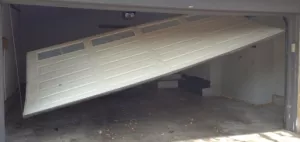
It is troubling when your garage makes noises and doesn’t seem to work right. You will naturally want to figure out what the problem is. You need to be careful when doing so, as detailed in these 5 cases where you should not try to repair a part that is broken or worn. Doing so is simply too risky.
Broken, slack or frayed lifting cables
The basics:
- Lifting cables join together the bottom of the door and the spring system. They wrap across a drum that contains grooves for proper placement of the cable.
- Because the lifting cables are attached to the bottom section of the spring system, everything has high tension. This tension equates to the combined weight of the door. Attempting to remove the lifting cable on the bottom of the door is a risky maneuver, so do not try it.
Why they can malfunction:
- If the drum is not properly positioned or misaligned, the cable is likely to fray due to misaligned drum grooves.
- If the cable isn’t the proper diameter for the size and weight of the door, there is a high risk of breakage.
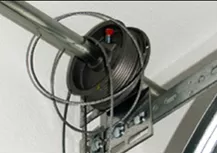
Broken lifting cable
Broken/stretched springs
The basics:
- The springs on a garage door act as a counterbalance to door’s weight, no matter what its size or composition.
- A garage door that is balanced properly with springs will weigh roughly 8 to 10 lbs. (3.5 and 4.5 kilos). This is what makes it is easy to open the door with only one hand.
Why they can malfunction:
- The average lifespan of Torsion and extension springs is roughly 5 to 7 years. This amounts to about 10,000 to 12,000 cycles (a cycle = one open + one close).
- You can expect torsion spring to lose 10% to 15% of its tension every year. Do not even bother trying to crank the spring tighter to get more tension. It will break when its lifespan is about over. If you hear a loud popping sound, it is likely that a spring has broken.
- For extension springs, the culprit is usually a result of the springs stretching. If a break occurs, it will usually take place at the end of the spring, inside the loop. A spring that is stretched will not give the best performance, as well. Since there are two springs, both right over the horizontal tracks, the door can still be raised and lowered with some shaking. This is where the strange noises come from.
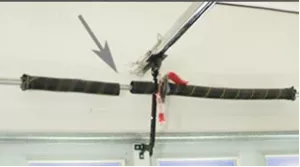
A broken TORSION spring
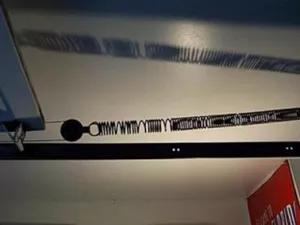
A stretched EXTENSION spring
Misaligned horizontal tracks
The basics:
- Horizontal tracks attach to the ceiling with a right-angle metal bracket.
- These need to be attached solidly and then screwed into a portion of the wood (rafter).
Why they can malfunction:
- When the triangle that forms the attachment point for the horizontal tracks is not completed properly, vibrations caused by the opening and closing of the door can cause the tracks to become misaligned. This can possibly lead to the door falling.
- If this does happen to you, do not try to pick up the door yourself. Leave it where it is and contact a garage door technician as soon as possible.

Misaligned horizontal tracks
Worn rollers
The basics:
- Rollers on the market vary significantly in terms of quality. If they contain ball bearings, the roller will last longer the more bearings there actually are.
- Black nylon rollers are also available. These contain no ball bearings. The cylinder that secures the rollers is galvanized and resistant to corrosion.
- For double garage doors, it is recommended that you have rollers of the long-stem variety installed in double hinges.
Why they can malfunction:
- Many people fail to remember that rollers need to roll in the tracks and not the slide.
- Breakage often occurs on double doors that are not equipped with long-stem rollers and double hinges on the respective ends of the door.
- If the door is open for long stretches of time, and it only has a single roller, the weight that ends up on the rollers tend to cause wear more quickly.
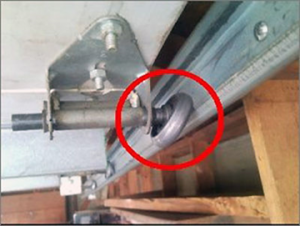
Worn‑out roller
Broken or stripped door opener gear and sprocket
The basics:
- Many garage door opener parts are made of plastic, such as the motor gear. This gear is comprised of rigid plastic, but breakage is possible if the drive chain causes too much pressure to be placed on it.
Why they can malfunction:
- A spring that is broken means that the weight of a door will become unbalanced. Remember, a door that balanced correctly will weigh about 8 to 10 lb. (3.5 and 4.5 kilos).
- Some lower end door openers are not designed to lift heavy weights. If a grinding sound is heard coming from your door opener, make sure that a spring has not broken.
- In order to open a door after the spring has broken, pull down on the emergency cord to dislodge the door opener and open the door manually.
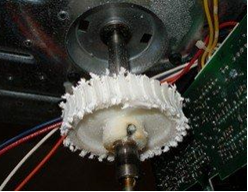
A door opener gear that needs to be replaced
A last piece of advice…
It is always best to allow a professional to handle repairs of this nature. Your safety is not worth risking on this. Feel free to contact us anytime at 705-322-0136.
We can also help you change out your garage door, and we are happy to visit you at your house and discuss the full range of garage door products available at the current time. We are also able to provide you with a quotation by email. You can gain a vision of what your next garage door can look like by visiting our Design Centre or by browsing our image gallery.








Add new comment